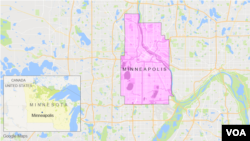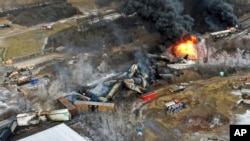The National Transportation Safety Board is investigating what caused a train to derail Thursday in Minnesota, forcing hundreds of residents to evacuate. Crews have started removing contaminated soil and damaged rail cars in the wake of the fiery derailment. No injuries have been reported.
Around 1 a.m. Thursday, 22 cars of a freight train derailed in the Midwest U.S. state of Minnesota near the town of Raymond. Ten of the tanker cars contained ethanol, a chemical that can be harmful to people. Four damaged cars containing ethanol erupted in flames and burned for several hours after the derailment. Environmental Protection Agency officials arrived at the scene by 6:30 a.m. and started monitoring the air for toxic chemicals.
The entire town of Raymond was evacuated in the night by first responders. Many residents were sent to a school and church in nearby Prinsburg. The evacuation order was lifted around noon.
The United States has been increasingly concerned about rail safety following the Norfolk Southern derailment in East Palestine, Ohio, in early February. Several thousand people had to evacuate after that derailment and are worried about lingering health issues after officials released and burned toxic chemicals to prevent an explosion. Officials have assured residents that no toxic chemicals were found in the air and water, but residents remain uneasy.
At a news conference Thursday, Minnesota Gov. Tim Walz and railroad officials said they aren’t especially concerned about groundwater contamination from the derailment there because a lot of the ethanol burned off and the ground remains frozen at this time of year.
The U.S. Energy Information Administration says pure ethanol is biodegradable and if spilled, it will break down into harmless substances.
“We will have our team here until this is cleaned up,” BNSF CEO Katie Farmer said at the news conference.
Major freight railroads have said they plan to add about 1,000 more trackside detectors nationwide to help spot equipment problems, but lawmakers have proposed additional reforms they want the railroads to make to prevent future derailments.
A group of Ohio representatives said at a news conference Thursday that the Minnesota derailment reinforces the need for reform.
The Ohio derailment sparked a bipartisan bill called the Rail Safety Act, which U.S. President Joe Biden supports, but the bill has yet to be passed by the Senate. The act would mean enhanced safety procedures for trains that carry hazardous materials, a two-person crew minimum and increased civil penalties over crashes.
Well-known food processing company ADM confirmed that the ethanol came from its corn processing facility in Marshall, Minnesota.
David Schneider is a lawyer who lives in Willmar, Minnesota, a town about 25 kilometers from the crash site. His family owns farms in and around Raymond. Upon hearing of the incident, he was worried the farms might be affected by the ethanol and corn syrup spillage. However, after learning more information, he says his fields are too far away from the derailment to be affected.
Schneider drove near the derailment around midday Thursday and could see smoke in the distance from the Raymond area. He said he has one friend that was evacuated.
“A lot of jobs depend on the production and transportation of ethanol, so I was relieved when I learned nobody was hurt,” he said. “But the economic consequences of this event may yet to be determined.”
Schneider emphasized that railroads are an important part of Minnesota’s history and economy.
“We in Western Minnesota were built by the railroads. Some of these towns are named after family members of the railroad… We are here because of the railroads.”
There were at least 1,164 train derailments across the U.S. last year, according to data from the Federal Railroad Administration. That means the country is averaging roughly three derailments per day.
“All it takes is one piece of worn-out equipment or broken equipment… Something comes loose, you can have a cascading effect,” Schneider said.
NTSB investigators are working to determine what caused the derailment, but it could be weeks before their findings are released.
Some information from this report came from The Associated Press.






